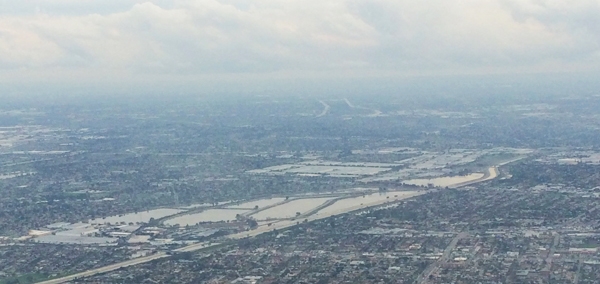Early in its development, Los Angeles bound itself tightly to the rest of California by securing a water supply piped in from locations across the state. The preference for distant water sources had far reaching ramifications for the region, including dependence on the happenings – weather and otherwise – in those faraway places. It also functioned to mask the local water supplies that LA actually has.
The penchant for long-distance water led to the creation of a vast and expensive infrastructure system. It also spurred the development of a plethora of agencies – over 100 at this point – created to manage that imported water.
In a recent paper, Stephanie Pincetl, director of the California Center for Sustainable Communities at UCLA, and co-authors argue that investments made over the years to fortify the city's supply with additional imported water have not solved LA's water shortages. Moreover, these approaches appear even less likely to help LA successfully navigate an uncertain water future.
Actions for a water independent LA
Erik Porse with the Office of Water Programs at Sacramento State and a co-author on the paper asserts that LA could become water self-reliant by strategically investing in local supplies, and offers several concrete strategies for improving LA's water security. These include focusing on better groundwater management, and improving the capacity to utilize stormwater and recycled water.
In addition, the researchers suggests that landscaping in LA be overhauled to dramatically reduce outdoor water usage. At the same time, they acknowledge that landscaping changes will have consequences, such as the potential for increasing urban heat islands, and therefore must be phased in over time.
Climate change underscores need for water reforms
Cities like LA that are reliant on distant water sources are also facing big complications due to climate change. For example, Pincetl notes that LA's continued dependence on already precarious water supplies from other regions of the state, such as the Sierra Nevada, will only exacerbate its own climate challenges.
This is particularly true during times of extended drought. “Amending LA's water supply with distant sources only during years where water is abundant in those places is a critical, and ultimately positive, shift that we have to make,” says Pincetl.
Instead, recognizing that LA does indeed have its own water supplies and that those can be bolstered with strategic investment—versus the sense that the region is doomed to a water-less, apocalyptic fate beyond its control—is reason for optimism.
Institutional reform is biggest challenge
In transitioning from a dependence on distant water sources to enhancing and protecting local supplies, Pincetl suggests that infrastructural and institutional reform are key. And, she emphasizes that the latter is the larger challenge.
Porse says that groundwater basin management offers a good example of the institutional challenges that managers will face in enacting these changes. “Groundwater pumping rights are adjudicated and codified by agreements that took decades to craft. Based on those agreements, some users do not have rights to pump or store groundwater, even though it will be a critical source of supply in the future. The change is conceptually straightforward, but much more difficult to enact.”
"The hardest part is really to alter the institutions that were created in the 20th century so that they can better deal with the challenges of the 21st century. Although it will take effort, I do really believe it's possible. We just need to get to work,” says Pincetl.
Reference: Pincetl, S., E. Porse, K.B. Mika, E. Litvak, K.F. Manago, T.S. Hogue, T. Gillespie, D.E. Pataki, and M. Gold. 2018. Adapting Urban Water Systems to Manage Scarcity in the 21st Century: The Case of Los Angeles. Environmental Management doi.org/10.1007/s00267-018-1118-2
